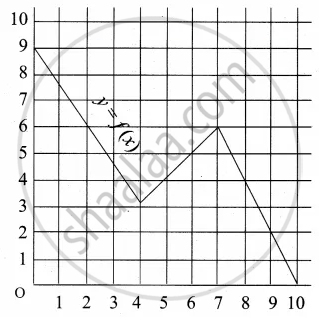Advertisements
Advertisements
प्रश्न
If f(x) = 4x − x2, x ∈ R, then write the value of f(a + 1) −f(a − 1).
उत्तर
Given:
f(x) = 4x − x2, x ∈ R
Now,
f(a + 1) = 4(a + 1) -(a + 1)2
= 4a + 4 -(a2 + 1 + 2a)
= 4a + 4 -a2 -1 - 2a
= 2a -a2 + 3
f(a -1) = 4(a -1) - 1) +1)2
= 4a-4 - (a2 + 1 -2a)
= 4a - 4 - a2 -1 + 2a
= 6a - a2 -5
Thus,
f(a + 1) − f(a − 1) = ( 2a -a2 + 3) -(6a -a2 -5)
= 2a -a2 + 3 -6a + a2 + 5
= 8 -4a
= 4(2 -a)
APPEARS IN
संबंधित प्रश्न
What is the fundamental difference between a relation and a function? Is every relation a function?
find: f(1), f(−1), f(0) and f(2).
f, g, h are three function defined from R to R as follow:
(ii) g(x) = sin x
Find the range of function.
The function f is defined by \[f\left( x \right) = \begin{cases}x^2 , & 0 \leq x \leq 3 \\ 3x, & 3 \leq x \leq 10\end{cases}\]
The relation g is defined by \[g\left( x \right) = \begin{cases}x^2 , & 0 \leq x \leq 2 \\ 3x, & 2 \leq x \leq 10\end{cases}\]
Show that f is a function and g is not a function.
If f(x) = x2 − 3x + 4, then find the values of x satisfying the equation f(x) = f(2x + 1).
If f(x) = loge (1 − x) and g(x) = [x], then determine function:
(ii) fg
If f is a real function satisfying \[f\left( x + \frac{1}{x} \right) = x^2 + \frac{1}{x^2}\]
for all x ∈ R − {0}, then write the expression for f(x).
If f(x) = cos [π2]x + cos [−π2] x, where [x] denotes the greatest integer less than or equal to x, then write the value of f(π).
Let \[f\left( x \right) = \frac{\alpha x}{x + 1}, x \neq - 1\] . Then write the value of α satisfying f(f(x)) = x for all x ≠ −1.
Let A and B be two sets such that n(A) = p and n(B) = q, write the number of functions from A to B.
Let f and g be two real functions given by
f = {(0, 1), (2, 0), (3, −4), (4, 2), (5, 1)} and g = {(1, 0), (2, 2), (3, −1), (4, 4), (5, 3)}
Find the domain of fg.
If f(x) = cos (log x), then the value of f(x) f(y) −\[\frac{1}{2}\left\{ f\left( \frac{x}{y} \right) + f\left( xy \right) \right\}\] is
The range of f(x) = cos [x], for π/2 < x < π/2 is
If f(x) = cos (log x), then value of \[f\left( x \right) f\left( 4 \right) - \frac{1}{2} \left\{ f\left( \frac{x}{4} \right) + f\left( 4x \right) \right\}\] is
If f(x) = cos (loge x), then \[f\left( \frac{1}{x} \right)f\left( \frac{1}{y} \right) - \frac{1}{2}\left\{ f\left( xy \right) + f\left( \frac{x}{y} \right) \right\}\] is equal to
f is a real valued function given by \[f\left( x \right) = 27 x^3 + \frac{1}{x^3}\] and α, β are roots of \[3x + \frac{1}{x} = 12\] . Then,
The domain of definition of the function f(x) = log |x| is
If f(x) = `{(x^2 + 3"," x ≤ 2),(5x + 7"," x > 2):},` then find f(2)
Check if the relation given by the equation represents y as function of x:
x + y2 = 9
If f(m) = m2 − 3m + 1, find f(0)
If f(m) = m2 − 3m + 1, find f(−3)
Find the domain and range of the follwoing function.
h(x) = `sqrt(x + 5)/(5 + x)`
Check the injectivity and surjectivity of the following function.
f : R → R given by f(x) = x2
Express the following logarithmic equation in exponential form
`log_5 1/25` = – 2
Find the domain of f(x) = ln (x − 5)
Write the following expression as sum or difference of logarithm
In `[(root(3)(x - 2)(2x + 1)^4)/((x + 4)sqrt(2x + 4))]^2`
Solve for x.
log2 + log(x + 3) – log(3x – 5) = log3
Select the correct answer from given alternatives
If f(x) = 2x2 + bx + c and f(0) = 3 and f(2) = 1, then f(1) is equal to
Answer the following:
Find whether the following function is one-one
f : R − {3} → R defined by f(x) = `(5x + 7)/(x - 3)` for x ∈ R − {3}
A function f is defined as : f(x) = 5 – x for 0 ≤ x ≤ 4. Find the value of x such that f(x) = 3
Answer the following:
If `log ((x - y)/5) = 1/2 logx + 1/2 log y`, show that x2 + y2 = 27xy
Answer the following:
Find the range of the following function.
f(x) = |x – 5|
A graph representing the function f(x) is given in it is clear that f(9) = 2

What is the image of 6 under f?
A function f is defined by f(x) = 3 – 2x. Find x such that f(x2) = (f(x))2
If f(x) = 5x - 3, then f-1(x) is ______
If f(x) = `{{:(x^2",", x ≥ 0),(x^3",", x < 0):}`, then f(x) is ______.
Find the range of the following functions given by `sqrt(16 - x^2)`
Let A and B be any two sets such that n(B) = p, n(A) = q then the total number of functions f : A → B is equal to ______.
Find the domain and range of the function f(x) = `1/sqrt(x - 5)`
